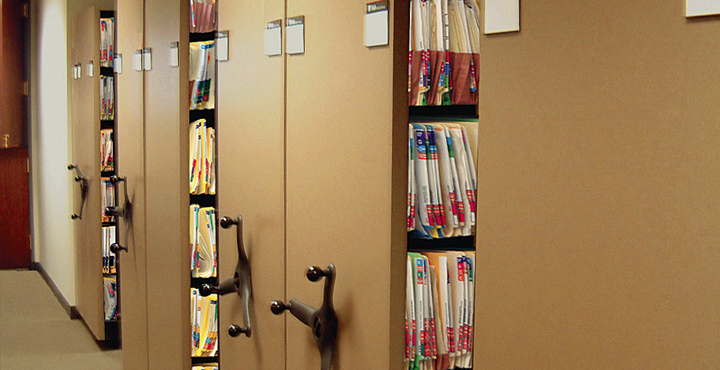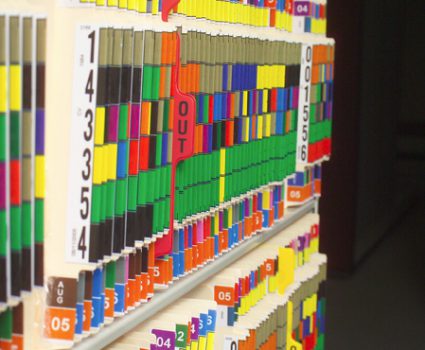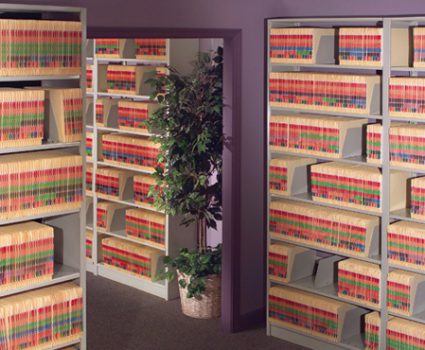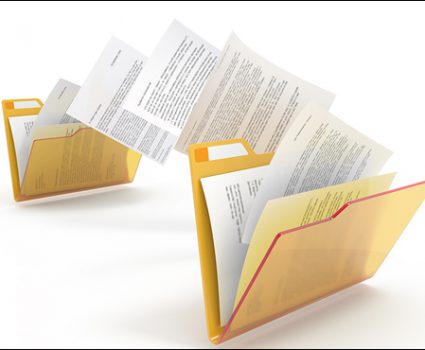
Physical records: how to free up space and reduce storage costs – Part 2
In last week’s blog post we looked at how a program of records retention and destruction can significantly reduce the volume of paper documents. The program involves purging non-records, establishing retention schedules and following through with the documented destruction of records that have passed their retention periods.
This week we outline several filing and storage practices that can free up additional space and save even further on the cost of storing physical records.
Filing and storage matters
An organization’s choice of file folders, cabinets and shelving all have a significant impact on the amount of floor space required to store physical records.
To illustrate, we will compare the space requirements under traditional systems versus newer, best practice approaches.
- Lateral vs. Vertical Filing. Traditional vertical filing cabinets make use of pull-out drawers, with files arranged from front to back. The flaw of this design is that you must leave room in front of the shelving unit to pull out the drawers. With traditional filing cabinets, the ratio of floor-space to storage-space is two to one. For example, a three-foot by one-foot traditional filing cabinet actually requires six square feet of floor space to accommodate the open drawers.
Lateral filing systems avoid this inefficiency by arranging files from left to right. Each file on the shelf is located at the front of the cabinet. Assuming the lateral shelving has a drawer (which not all do), the space required in front of the unit is no more than 14 inches, which is the length of a legal-sized folder. Replacing a three-foot vertical cabinet with a lateral filing unit reduces the required clearance space in front of the cabinet from three feet to 14 inches. When this space savings is multiplied by dozens, hundreds or even thousands of filing cabinets across the organization, the savings can really add up.
- End-tab vs. Top-tab Folders. In traditional, “top-tab” folders, the labels are affixed to a tab which protrudes out the top of the folder. With end-tab file folders, labels are affixed to a tab at the side of the folder. This design feature is what enables the use of lateral shelving, which as we have just discussed, saves a great deal of floor space. Instead of having to pull out a drawer to skim through top tabs, staff members can simply scan the end tabs at the front of the lateral shelving unit.
Another benefit of end-tab folders is that you can fit more shelves into a given vertical space. With top-tab folders you need to leave space above each folder to accommodate the tab itself. In a multi-shelf filing cabinet, this adds up to a lot of wasted space. With end-tab folders, you eliminate these gaps, freeing more vertical space for storage.
- Mobile vs. Stationary Shelving. On their own, lateral filing cabinets and end-tab folders can dramatically reduce your physical storage footprint. However, when space is really at a premium, you can achieve even greater savings through the use of mobile shelving. With mobile shelving, rails are used to slide shelves back and forth, providing access to additional shelves in the back. This mobility eliminates the need for multiple “access aisles”, which frees more space for storage. For example, say you have five lateral shelving units arranged in rows. To provide access to each fixed shelf, you would need to create four permanent aisle spaces between the rows. With mobile shelving, you can reduce that to a single row of access space, which allows you to install additional shelves in the same space. Depending on the style of mobile shelving used, you can improve your use of storage space by over 300 percent!
When you combine these best practices with the recommendations in our last blog post, the space and cost savings can be impressive. The great news is that achieving these results is within reach of every organization. It only requires a systematic approach to managing paper records and the adoption of a few filing best practices.
Next Steps
- Learn more about these best practices in our free guide, Doing More with Less, Space Planning in Records Management
- Get help choosing a mobile shelving solution in our free buyer’s guide
- Contact TAB for more tips on how to managing your physical records.





